Growing up in my Lola's kitchen in Quezon City, I learned that the secret to the perfect chicken adobo isn't just in the ingredients – it's in the patience and love you put into each step. This recipe, passed down through generations and perfected in my own kitchen, transforms humble pantry staples into the most comforting Filipino dish you'll ever make.
The first time I cooked this for my kids, watching them fight over the last crispy potato that had soaked up all that garlicky-savory sauce, I knew I had finally mastered my grandmother's technique. But here's what makes this version special – we're adding golden-brown potatoes that become irresistibly crispy on the outside while staying tender inside, making this classic adobo even more ulam-worthy.
Jump to:

Why You'll Love This Recipe
- Perfect Balance: Master the signature Filipino adobo taste of sour, salty, and savory
- One-Pan Wonder: Everything cooks in a single pan for easy cleanup
- Better Next Day: Flavors deepen overnight, making leftovers even more delicious
- Crowd Pleaser: Impresses everyone from picky eaters to traditional Filipino elders
- Budget-Friendly: Uses simple pantry ingredients
- Meal Prep Champion: Keeps well and reheats beautifully
- Authentic Technique: Traditional method with modern, detailed instructions
Ingredients
Each component in this recipe has a specific purpose: bone-in chicken provides rich flavor and stays juicy, while the combination of vinegar and soy sauce creates that signature adobo tang. Plenty of garlic forms the aromatic base, bay leaves and peppercorns add depth, and russet potatoes are perfect for absorbing sauce while maintaining their structure.
This ingredient list isn't complicated, but it delivers maximum flavor from simple, everyday items you probably already have in your kitchen.
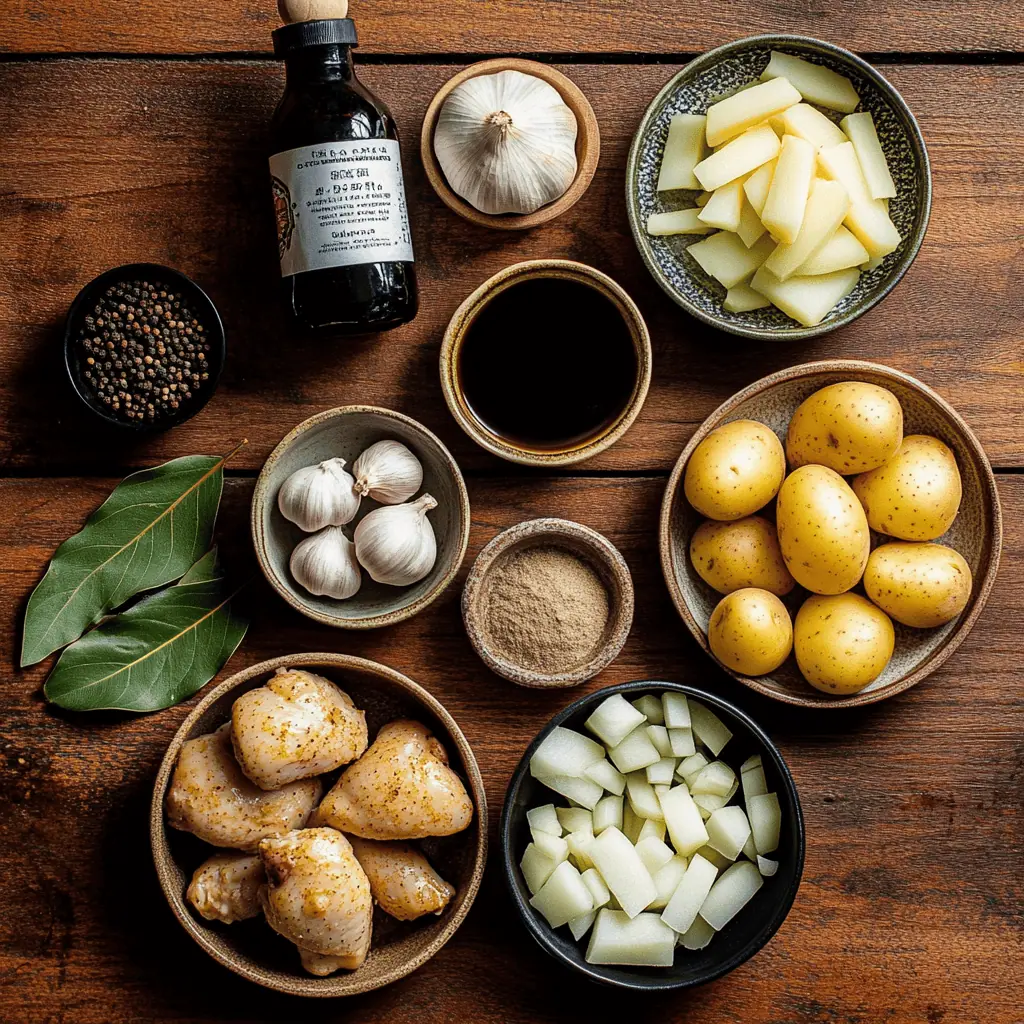
- 3-4 pounds whole chicken, cut into serving pieces (bone-in, skin-on)
- 1 whole head garlic (about 12 cloves), peeled and minced
- 1 large white or yellow onion, thinly sliced
- ¼ cup Filipino soy sauce (Marca Piña or Silver Swan recommended)
- ½ cup palm vinegar or white vinegar (Filipino cane vinegar preferred)
- 2 bay leaves (laurel leaves)
- ½ teaspoon whole black peppercorns
- 2 large russet potatoes, peeled and cut into 1-inch rounds
- ¼ cup cooking oil (neutral oil like canola or vegetable)
- 1 cup water (preferably filtered)
- Salt to taste
- Optional: 1 teaspoon brown sugar for balance
- Optional garnish: sliced green onions and fried garlic bits
Equipment
- Heavy-bottomed skillet or Dutch oven (12-inch recommended) - The thick base prevents burning and distributes heat evenly for perfect browning
- Kitchen tongs - For safely turning chicken pieces without piercing them, keeping juices intact
- Sharp chef's knife - For cutting potatoes uniformly and preparing chicken if not pre-cut
- Measuring cups and spoons - For precise ingredient measurements, crucial for the perfect adobo balance
- Meat thermometer - To ensure chicken reaches the safe temperature of 165°F/74°C
- Cutting board - Preferably with juice groove for handling raw chicken safely
- Mixing bowl - For marinating chicken (glass or non-reactive recommended)
- Garlic press (optional) - For efficiently mincing the large amount of garlic
- Slotted spoon - For removing fried potatoes without excess oil
- Paper towels or wire rack - For draining fried potatoes properly

How To Make
- Prepare the marinade: In a large glass or non-reactive bowl, combine chicken pieces, half of the minced garlic, sliced onions, soy sauce, peppercorns, and bay leaves. Using clean hands, gently massage the marinade into the meat to ensure even coating. Cover and refrigerate for at least 3 hours, preferably overnight (12-24 hours) for maximum flavor development.
- Bring to room temperature: Thirty minutes before cooking, remove the chicken from the refrigerator. This ensures even cooking. Drain the chicken and save the marinade separately – this flavorful liquid is essential for the sauce.
- Prepare the potatoes: Heat oil in your heavy-bottomed pan over medium heat (325°F/165°C). Test if the oil is hot enough by dropping a small piece of potato – it should sizzle immediately but not violently. Fry potato rounds in a single layer until golden, about 3-4 minutes per side. Remove to a paper towel-lined plate or wire rack. This first fry is to cook the potatoes through.
- Brown the chicken: Increase the heat to medium-high (375°F/190°C). Leave just 1-2 tablespoons of oil in the pan. Place marinated chicken pieces skin-side down in a single layer. Allow them to brown properly on all sides, about 3-4 minutes per side. Don't overcrowd the pan; work in batches if needed. This browning creates depth of flavor and improves texture.
- Develop the aromatics: Lower heat to medium (350°F/175°C) and add remaining minced garlic. Sauté just until fragrant, about 30 seconds – be careful not to burn it as this will create bitterness.
- The vinegar technique: Pour in the vinegar but DO NOT STIR for 3-4 minutes. This traditional Filipino technique called 'pangasim' allows the harsh acidic edge to cook off while preserving the vinegar's tanginess. You'll notice the strong vinegar smell mellowing.
- Create the adobo base: After the vinegar has boiled untouched, pour in your reserved marinade and water. Bring everything to a boil, then reduce to a gentle simmer. Cover the pot and let it cook for 20-25 minutes, or until the chicken is tender and reaches an internal temperature of 165°F/74°C.
- Second-fry the potatoes (optional for maximum crispiness): While the chicken simmers, you can briefly re-fry the potatoes at 350°F/175°C for 1-2 minutes to achieve extra crispiness. This double-frying technique creates the perfect texture contrast.
- Combine and reduce: When the chicken is tender, add your fried potatoes back to the pan. Continue cooking uncovered until the sauce has reduced and thickened enough to coat the back of a spoon, about 10 minutes. Taste and adjust seasoning with salt if needed. If you find it too sour, add a small amount of brown sugar to balance the flavors.
- Rest and serve: Let your adobo rest for 10 minutes before serving. This allows the flavors to settle and the meat to become even more tender. Serve hot over steaming white rice, garnished with sliced green onions and crispy garlic bits if desired.

Tips From Lola's Kitchen
- Choose the right cuts: Thighs and legs work best as they stay juicier and more flavorful. Avoid breast meat which can become dry.
- Vinegar power: The quality and type of vinegar dramatically affects the final taste. Try different Filipino vinegars like sugarcane, coconut, or palm for unique flavor profiles.
- Garlic technique: Crush garlic cloves slightly before mincing to release more essential oils and flavor.
- The perfect sear: Ensure chicken skin is completely dry before browning for the crispiest exterior.
- Sauce consistency secret: If your sauce isn't thickening, remove the chicken and potatoes temporarily and reduce the sauce on higher heat, then return them to the pan.
- Rest period: Always let adobo rest at least 10 minutes before serving – the flavors continue to develop even after cooking.
- Make ahead: For best flavor, make adobo 24 hours in advance and reheat gently before serving.
- Oil selection: When frying potatoes, peanut oil or rice bran oil create exceptional crispiness.
- Temperature control: Keep heat at a gentle simmer during braising to prevent toughening of the meat.
- Garlic preservation: Save some fried garlic bits from the initial sautéing for garnish at the end.
Substitutions
- Chicken: Turkey thighs, pork shoulder cut into 2-inch chunks, or firm tofu for vegetarian version (reduce cooking time accordingly)
- Vinegar: Apple cider vinegar (milder), white wine vinegar, or rice vinegar (reduce amount by 1 tablespoon as it's less potent)
- Soy sauce: Coconut aminos for gluten-free version (use ⅓ cup as it's less salty), tamari, or Bragg's Liquid Aminos
- Potatoes: Sweet potatoes, taro root, or yucca for interesting flavor variations
- Bay leaves: Fresh curry leaves (2-3) or ¼ teaspoon dried thyme
- Peppercorns: Ground black pepper (¼ teaspoon) or ½ teaspoon crushed coriander seeds
- For spicy lovers: Add 2-3 Thai bird's eye chilies with the garlic
- Lower sodium option: Reduce soy sauce to 2 tablespoons and increase water by 2 tablespoons
- Sugar-free version: Use a small piece of grated carrot to balance acidity naturally
Troubleshooting
- Sauce Too Sour
- Add ½ teaspoon sugar at a time
- Cook longer to reduce vinegar taste
- Balance with additional soy sauce
- Chicken Not Tender
- Extend cooking time by 10-15 minutes
- Ensure proper heat level (gentle simmer)
- Check chicken size (larger pieces need more time)
- Sauce Too Thin
- Simmer uncovered to reduce
- Remove chicken and reduce sauce separately
- Add cornstarch slurry as last resort
Storage & Reheating
- Refrigerator: Store in an airtight container for 3-4 days. The flavor actually improves after 24 hours!
- Freezer: Freeze without potatoes for up to 3 months in freezer-safe containers. Freeze potatoes separately.
- Reheating methods:
- Stovetop (best method): Reheat gently over medium-low heat with a splash of water to revive the sauce
- Microwave: Heat in 1-minute intervals at 70% power, covered with a damp paper towel
- Oven: 325°F/165°C in a covered dish for 15-20 minutes
- Make the potatoes crispy again: Separate potatoes and briefly reheat in a hot skillet or air fryer for 2-3 minutes to restore crispiness

FAQ
Can I use boneless, skinless chicken?
Yes, but reduce cooking time by about 10 minutes and add 1 tablespoon of oil to the marinade to compensate for the missing fat from the skin.
Why does my adobo taste too vinegary?
Make sure you've followed the "pangasim" technique of letting the vinegar boil untouched for 3-4 minutes. If still too sour, add ½ teaspoon of brown sugar at a time until balanced.
How can I make sure my potatoes stay crispy?
The double-frying technique is key. Also, add potatoes to the sauce only in the final 5 minutes of cooking, or keep them separate and spoon the reduced sauce over them when serving.
Can I make this in a slow cooker or Instant Pot?
Yes! For slow cooker: Brown chicken first, then cook on low for 6 hours. For Instant Pot: Brown chicken using sauté function, then pressure cook for 10 minutes with 10-minute natural release. In both cases, fry potatoes separately.
My sauce isn't thickening, what should I do?
Remove the chicken and potatoes temporarily, then boil the sauce on higher heat until reduced. For a quicker solution, mix 1 teaspoon cornstarch with 1 tablespoon cold water and stir into the simmering sauce.
Is this recipe gluten-free?
Not as written due to the soy sauce. Substitute with coconut aminos or gluten-free tamari for a gluten-free version.
How can I make this healthier?
Use skinless chicken thighs, reduce oil to 2 tablespoons, bake the potatoes instead of frying, and use low-sodium soy sauce.
What makes Filipino adobo different from Mexican or Spanish adobo?
Filipino adobo uses vinegar as its main preserving agent, while Mexican and Spanish versions use dried chilies, paprika, and oregano. The cooking methods and flavor profiles are completely different despite sharing the same name.
Related
Looking for other recipes like this? Try these:
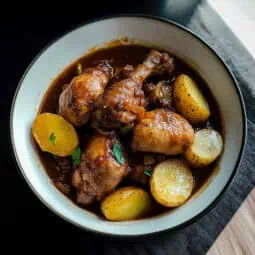
Filipino Chicken Adobo with Crispy Potatoes
Equipment
- Heavy-bottomed skillet or Dutch oven 12-inch recommended
- Tongs for turning chicken
- Knife for cutting
- Measuring cups and spoons
Ingredients
- 1 3-4 pounds whole chicken, cut into serving pieces
- 1 head garlic about 12 cloves, peeled and minced
- 1 large onion thinly sliced
- ¼ cup Filipino soy sauce Marca Piña or Silver Swan recommended
- ½ cup palm vinegar or white vinegar
- 2 bay leaves laurel leaves
- ½ teaspoon whole black peppercorns
- 2 large potatoes peeled and cut into 1-inch rounds
- ¼ cup cooking oil
- 1 cup water
- Salt to taste
- Optional: 1 teaspoon brown sugar for balance
Instructions
- Take your chicken pieces (manok), half of the minced garlic (bawang), sliced onions (sibuyas), soy sauce (toyo), peppercorns (paminta), and bay leaves (dahon ng laurel), combining them in a large bowl. Using clean hands, gently massage (magmasahe) the marinade into the meat to ensure even coating. Cover the bowl and refrigerate for 3 hours or overnight for best results (mas masarap kung overnight).
- Thirty minutes before cooking, remove the chicken from the refrigerator to come to room temperature (hayaang umabot sa tamang temperatura). Drain the chicken but save the marinade (itabi ang pinagbabaran) – we'll use this later.
- Heat your oil (mantika) in a large skillet or Dutch oven over medium heat (350°F/175°C). Test if the oil is hot enough by dropping a small piece of potato – it should sizzle immediately. Fry your potato rounds until they turn golden brown (hanggang maging golden brown), about 3-4 minutes per side. Remove them to a paper towel-lined plate (patuyuin sa paper towel). Leave just 1 tablespoon of oil in the pan.
- Increase the heat to medium-high (375°F/190°C). Place your marinated chicken pieces skin-side down (balat sa ibaba) in the pan. Let them brown properly (hanggang maging golden brown) on all sides, about 3-4 minutes per side. Don't rush this step – good browning means more flavor (mas masarap). Remove excess oil if needed, leaving about 2 tablespoons in the pan.
- Lower the heat to medium (350°F/175°C) and add your remaining minced garlic. Sauté until fragrant (hanggang mabango), but don't let it brown. Now comes an important step: pour in your vinegar (suka) but DO NOT STIR (huwag haluin) for 3-4 minutes. This traditional technique, called 'pangasim', helps mellow the harsh acidity of the vinegar.
- After the vinegar has been boiling for a few minutes, pour in your reserved marinade and water (tubig). Bring everything to a boil, then reduce to a gentle simmer (pakuluan nang marahan). Cover the pot and let it cook for 20-25 minutes, or until the chicken is tender and reaches an internal temperature of 165°F/74°C. The meat should easily pull away from the bone (madaling matanggal sa buto).
- When the chicken is tender, add your fried potatoes back to the pan. Continue cooking uncovered until the sauce has reduced and thickened enough to coat the back of a spoon (hanggang lumapot ang sarsa). This usually takes about 10 minutes. Taste and adjust the seasoning with salt (asin) if needed. If you find it too sour, you can add a small amount of brown sugar (asukal na pula) to balance the flavors.
- Let your adobo rest for 10 minutes before serving. This allows the flavors to settle and the meat to become even more tender. Serve hot over steaming white rice (mainit na kanin), garnished with crispy garlic (sinangag na bawang) if desired. Don't forget to spoon plenty of that rich, dark sauce over the rice – that's where all the flavor is!
- Remember, adobo always tastes better the next day (mas masarap kinabukasan), so don't hesitate to make it in advance. The flavors will continue to develop and deepen overnight in the refrigerator.
Tips from Lola's Kitchen
- Use bone-in chicken for maximum flavor
- Don't skip the browning step - it's crucial for depth
- Keep vinegar ratio balanced
- Let vinegar boil without stirring to cook off harsh acidity
- For crispier skin, broil chicken pieces for 2-3 minutes before serving
- Potatoes should be golden brown like toasted bread
- Chicken is done when it easily pulls from bone
- Sauce should be thick enough to coat your spoon
- For food safety, chicken should reach 165°F/74°C
Nutrition
The Story Behind Chicken Adobo
Filipino Chicken Adobo (Adobong Manok) stands as the Philippines' unofficial national dish, though its story challenges common assumptions. While many believe the dish originated from Spanish colonization due to its name "adobo" (meaning marinade), the cooking method actually predates Spanish arrival in the Philippines. Long before colonization, native Filipinos were already preparing their food using vinegar and salt as preservation techniques—a practical necessity in the tropical climate before refrigeration.
What makes Filipino adobo truly special is its evolution through time. The pre-colonial version started with just vinegar and salt, but the recipe evolved as different cultures influenced the archipelago. Chinese traders introduced soy sauce, which became a crucial ingredient in the modern version. The Spanish contributed black peppercorns and bay leaves, creating the complex flavor profile we know today. Each Filipino region then developed its own variations, from the coconut milk-based Adobo sa Gata in Bicol to the turmeric-yellow adobo in the Visayas.
Today, every Filipino family claims their adobo recipe is the best—and they're all right. The beauty of adobo lies in its versatility and the way it represents Filipino cooking philosophy: adapting and improving while maintaining its soul. Whether cooked in a humble kitchen or a high-end restaurant, the dish's signature combination of vinegar, soy sauce, garlic, and spices continues to captivate palates worldwide, making it one of the most searched and celebrated Filipino recipes globally.
Remember: The perfect adobo isn't about following strict rules; it's about finding the balance of flavors that tells your family's story.







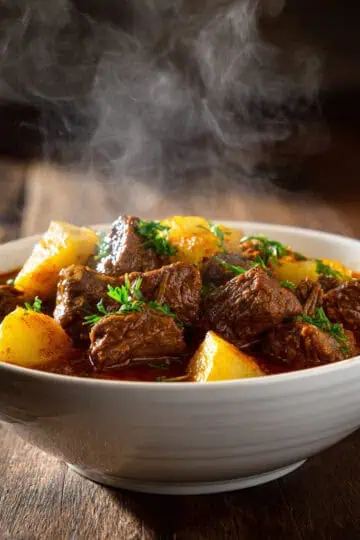
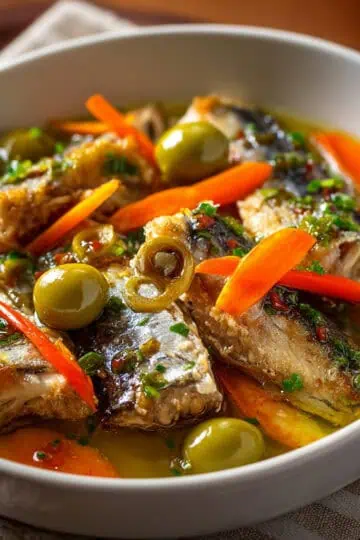
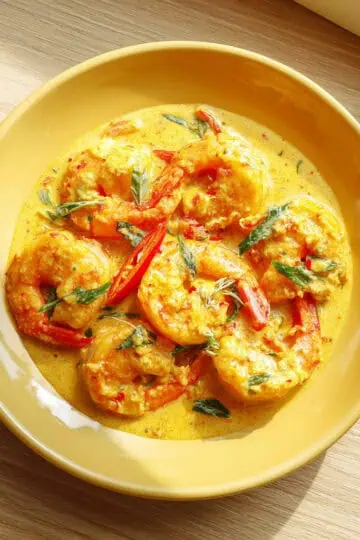
Comments
No Comments